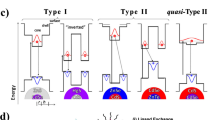Abstract
ZnO quantum dots (QDs)with the sizes of 3.0–5.6 nm are synthesized by solution-phase method at different temperatures. We find that temperature has great influence on the size of ZnO QDs. The growth process is the most sensitive to temperature, and the process is well explained by Lifshitz-Slyozov-Wagner (LSW) model. By photoluminescence (PL) spectra of the quantum dots at different temperatures and reactive time, we come to a conclusion that ultraviolet emission is mainly due to surface defects, and the origination of green visible emission comes from the transition between the bottom of the conduction band and the level of O i.
Similar content being viewed by others
References
CHEN Li, XIONG Jian-wen, LIU Gui-xiang, Journal of Optoelectronics Laser, 18 (2007), 1265(in Chinese)
LI De-na, ZHANG Bing-bo, MA Gui-ping, Chemical Journal of Chinese Universities, 29 (2008), 46.
Jana Nikhil R, Chen Yong-fen, Peng Xiaogang, Chemistry of Materials, 16 (2004), 3931.
Hu Ze-shan, Gerko Oskam, Journal of Colloid and Interface Science, 263 (2003), 454.
Wang Yong-hao, Zhang Jing, Yang Yan-lian, Journal of Physical Chemistry B, 111 (2007), 5290.
Pan Dao-cheng, Ji Xiang-ling, An Li-jia, Chemistry of Materials, 20 (2008), 3560.
Oskam G and Poot F D P, Journal of Sol-Gel Science and Technology, 37 (2006), 157.
Brus L. E, Nanostructured Materials, 1 (1992), 71.
Olshavsky M. A., Goldstein A. N. and Alivisatos A. P. Journal of the American Chemical Society, 112 (1990), 9438.
Wagner C Z. Zeitschrift fuer Elektrochemie and Angewandte Physikalische Chemie, 65 (1961), 581.
Sung Yun-mo, Park Kyung-Soo and Lee Yong-Ji. Journal of Physical Chemistry C, 111 (2007), 1239.
D.W. Bahnemann, C. Kormann, M.R. Hoffmann, The Journal of Physical Chemistry, 91 (1987), 3789.
Guo Lin, Yang Shi-he, Applied Physics Letters, 76 (2000), 2901.
Y. M. Sun, Ph. D. Thesis, Univessity of Science and Technology of China (Hefei, 2000) (in Chinese)
Author information
Authors and Affiliations
Corresponding author
Additional information
The work has been supported in part by National Natural Science Foundation of China(Grant No. 60877029), in part by the Tianjin Natural Science Foundation (Grant No. 07JCYBJC06400 06TXTJJC14600), and in part by the Subject of Science and Technology Development Fund at University of Tianjin (Grant No. 20071207)
Rights and permissions
About this article
Cite this article
Zhuang, JY., Li, L., Zhang, XS. et al. Influence of reaction temperature on the formation process of ZnO quantum dots and the optical properties. Optoelectron. Lett. 5, 1–5 (2009). https://doi.org/10.1007/s11801-009-8160-3
Received:
Published:
Issue Date:
DOI: https://doi.org/10.1007/s11801-009-8160-3




